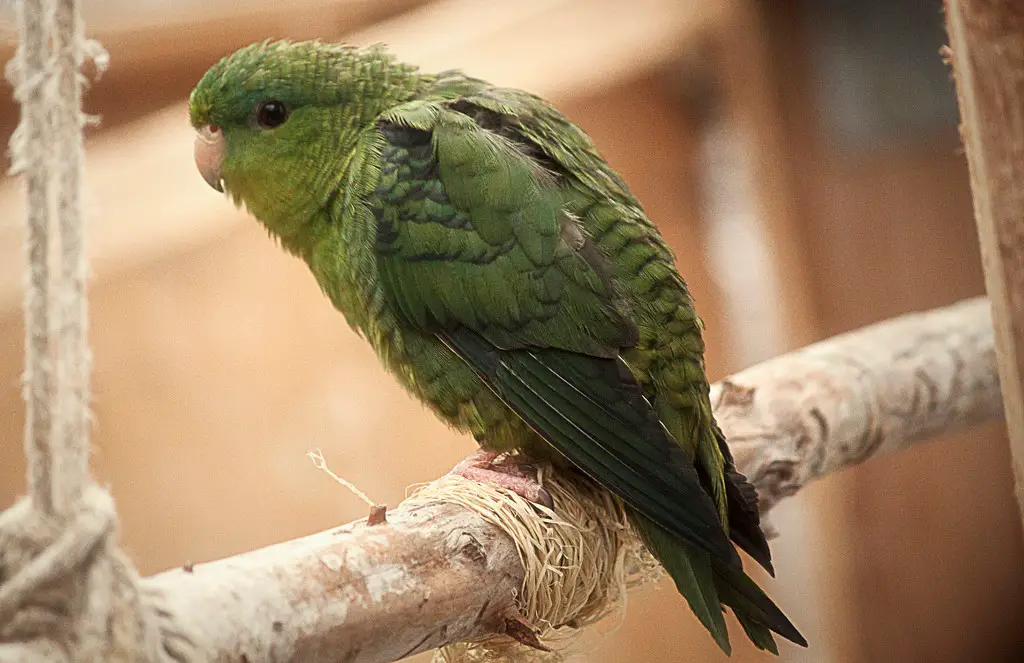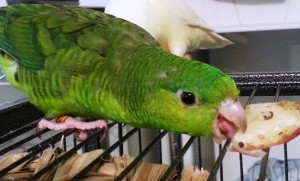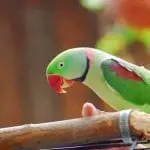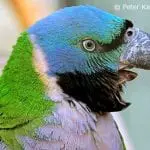Scientific Facts
| Common Name: | Barred Parakeet |
| Scientific Name: | Bolborhynchus Lineola |
| Life Span: | 10 to 15 years |
| Size: | 16 cm length |
| Habitat: | Forests and mountains |
| Country of Origin: | Mexico, Latin, and South America |

Physical Description
Barred parakeets are around 16 cm length and weigh around 42 to 52 grams. These birds, when in the wild exhibit feathers that are mostly green covered with dark green and black stripes on the back, sides, and wings. The lower side portion of the wings is color blue, while its tail feathers are in dark green. The shoulder of the wings is black. The underside of the wings has some traces of blue color. Their eyes are brown, and the beaks are horn-colored. The legs are pink. The young ones have lesser markings of dark stripes but, eventually, get darken as they get aged.
Captive-bred barred parakeets can exhibit a cluster of color variations – the color of the feathers changes after abandoning the wild, including cobalt, blue, white, and turquoise. The male and female barred parakeets are almost similar, though attentive spectators may observe that the stripes in black are more abundant in males.
Lifespan
The average lifespan of barred parakeets is 10 to 15 years. Although there have been noted cases of some barred parakeets to reach a lifespan of 20 years. The lifespan of these birds relies on the kind of breed and on the health of the individual bird, which is ultimately affected by diet and exercise.
Eating Habits
Barred parakeets constantly eat throughout the day. Hence, you must secure their food. Every barred parakeet has its preference for food when it comes to vegetables, fruits, treats, and a staple diet. Birds that are not acquainted with a diet with vegetables and fruits may have problems with taking new and unfamiliar foods. Many barred parakeets enjoy eating an apple, and this is commonly ideal entry food towards proposing other kinds of produce.

Sleeping Habits
Barred parakeets have various sleeping habits. Parakeets commonly sleep with their one leg raised. They do this because they want to control the heat loss from their legs. They close their eyes when they sleep. However, there are times that the barred parakeets will close their eyes because they are feeling cushy. Sometimes these birds wrap their heads underneath their wings to feel relaxed. Doing this makes them sleep easier because it appears darker, homey, and they can relax their head.
One can help his pet in getting enough sleep by covering the cage. The dark environment will give a perfect scenario so that the bird can sleep easily. Covering the cage can also obstruct some noise.
Development and Reproduction
The eggs normally take around 18 to 20 days before the hatching begins. When they begin to hatch, hatchlings are considered completely helpless, and the hen feeds them continuously. On day 10, the eyes of the chicks will open, and they begin to form feather down, which normally demonstrate the best period for putting closed bands to the chicks.
In the third week, they begin to develop feathers. At this period of development, the cocks normally have started to enter the nest to assist the mother in feeding and caring for the chicks. In their fourth week, the birds are expected to survive alone. And on the fifth week, the chicks develop stronger, and both the hen and the cock become comfortable leaving the nest often. The young birds will extend their wings to acquire strength before their first attempt of flying.

How to Breed
Determining Sexes
There is no distinguishing characteristic to determine the sexes of barred parakeets. Thus, sex should be done through surgery or blood tests. However, for some people who have great experiences with barred parakeets, they may be able to visually determine the sex through the coloration of the tail and shoulder, and length of the tail feathers. Males and females are distinct in the eminence of the dark stripes. Females may have less black feather edges, although this is not always the case –making it an uncertain science to utter the least. The hen has tails with confined black edges, so confined that in some circumstances, it is completely invisible.
Sexing can be done through Lutino mutation since breeding results shall immediately determine the sexes of the offspring.
Courtship and Mating
The male barred parakeet will stand in the back of the female barred parakeet while some contact in the beak is done between the mates. The male cloak his tail underneath the lifted tail of the female, position his cloaca against hers and grind it back and forth to provoke ejaculation. There are times that the male will move away for a while and go back for another session.
There are times that male parakeets will demonstrate courtship with similar sex, and females to court females too. There is a big chance of mistaking them for opposite sexes. Difficulties in breeding occur for different reasons. Certain chicks may die due to attacks or diseases.
Eggs and Incubation
Barred parakeets breed all year round. However, breeding is not recommended during the winter season and on severely heat weather. They need a hollow log or a hollow tree and considering that they typically need nest boxes to breed. Many parakeets like their nest box openings to be sufficiently big so they can clutch through. Hence, an independent hatch for inspection and cleaning must be included in the nest box. Various nesting containers must be given to identify which the pair likes to use. Unused boxed must be taken out when laying has started. The female parakeets can still lay eggs without the presence of their partner; however, they will be unfertilized.
A female bird lay eggs on rotating days, commonly a 2-day gap from the first one. She will normally lay eggs in between 4 to 12, which shall be incubated for around 19 days. The mothers only abandon their nests for stretches and fast defecations the moment they have started incubating. Relying on the size of the clutch and the start of incubation, there can be an age difference of 5 to 15 days between the first hatchlings and the last ones. There are normally 2 to 4 eggs in a clutch that hatch after around 18 to 21 incubation days.
Common Health Problems
Mites
Barred parakeets that form a massive scaley accumulation on the legs and beak may be infected by a mite like Knemidokoptes. If not treated, this parasite may trigger permanent beak impairments. Treatment normally includes an antiparasitic medicine like ivermectin. If you notice a weird appearance on the feet and beak of your pet, it would be best if you consult your veterinarian.
Diarrhea and Breathing Problems
Some of the non-particular indications that can be brought by infections, nutritional deficiencies, egg-laying, and poisoning are diarrhea and breathing problems. Fumbled, loss of appetite, and tail bobbing are also other signs. Give your parakeet an additional warmth and bring it to the vet immediately.
Too Much Egg Laying
Some females lay too many eggs in just a short time that they turn weak. Some of them even experience seizures because of low blood calcium. One should understand that this condition is life-threatening. Thus, the parakeet should be brought to a veterinarian immediately to receive proper medication.
Feather-tugging and scratching
A barred parakeet that is noticed to scratch itself frequently may be suffering from a parasitic infection, particularly the Giardia, or some other internal disorder or infection. If you notice your pet to be doing these, gather some samples of fresh moist fecal and put them in a Ziploc bag together with a dampened paper towel. Store it at room temperature and have your veterinarian check it.
Strange Droppings
Alterations in the droppings of the barred parakeet can be associated with a modification in diet. Normally, if it is caused by a treat, the droppings will eventually go back to normal in just a few hours. If not, it can be an indication of a serious illness like liver disease, kidney disease, infection, and many more. Gather some abnormal droppings and present it to your vet.
Tumor
Lameness can be an indication of a more crucial internal concern like a tumor. Tumors of the gonads and the kidneys may commonly trigger the parakeet to sit steadily while holding the one leg or limp up as it advances around the perches.
Preventing Illnesses
A lot of illnesses which barred parakeets suffer from are due to the deficiencies in the vitamin. Illnesses can be prevented by feeding the bird with fresh vegetables and fruits. Sprouted seeds are also great for diet because they work to inhibit fatty tumors since these birds are very vulnerable to it.
Behavior
If cared properly and hand-fed when they were still babies, barred parakeets grow sweet and easy-going characteristics. They are exceptionally natural social birds, and they enjoy spending time with their owners. Recognized for being amusing cute pets, the highly gregarious barred parakeet develops to be a charming family member. They do not get stressed when exposed to changes. They can adjust to new surroundings in just a little time. They are comparably bashful and rapidly set free their fear and become trustful with their owners.
Barred parakeets are quieter compared to other parakeets. They would normally chatter instead of screech. They can be good talkers, clearly articulated, although with higher limited vocabulary compared to other parrots. They are great at imitating whistles and sounds. Commonly, these birds twitter in the morning and the evening and seldom become boisterous unless there is a need to do so. They are natural acrobats, frequently inclined to clasp to the bars, and demonstrating tricks such as walking explicitly by striding one foot before the other.
Moreover, these birds are very dynamic and spend plenty of energy in the wild interacting and playing with their mates, searching madly for food, and ensuring that they are not caught by predators. Overall, these birds require 3 to 4 hours of playtime out-of-cage per day to acquire the appropriate amount of exercise. Probable owners must see to it that they can oversee their barred parakeets in a harmless, bird-proofed place during these sessions of playtime. They do entertaining stances such as hovering from the cage upside-down in one leg, notably in a mist bath, resting with the heads down while the tail is pointing upwards, or sitting horizontally.
Parakeets clean themselves through preening. They often do preening to take out the dust and dirt from the feathers. They also demonstrate their fondness to their friends through preening or by feeding one another. They feed one another by feeding the seeds themselves, then expelling it in the mouth of their friend. They work to clean the difficult-to-reach spots of each other.
Habitat
Enclosure
Barred parakeet is a little bird that does not need a big cage, although larger cage is more preferable. With one barred parakeet, the least possible measurement for a cage should be 24-inch square, as long as you are providing the bird expansive time for an outside-the-cage moment. Dimensions are common and medium and may widely differ, determined by the preferences of the owner and the bird.
This bird also executes comparably great in bird sanctuaries with other barred parakeets or correlated small varieties. However, be informed that little flocks can be a bit boisterous.
Toys and Branches
Even though they are not popular for casualty, barred parakeets will nibble and chew. Thus, it will be helpful if you give the bird a lot of adequate chew toys as well as natural wood branches, which will assist him in differentiating when chewing is tolerable.
Temperature
Because of the nature of its origin, barred parakeets can adjust to any kind of weather condition. However, a temperature that goes below 50 degrees Fahrenheit is not advisable. A temperature that is not too cold or too hot is recommended. Alterations in temperature, or intense temperatures, may affect the bird and make them feel distressed and even make them inclined to illness.
Diet
Barred parakeets should be feed with a proper diet of pellet mix and superior-quality seeds, together with a mixture of fresh vegetables and fruits that are considered safe for birds. However, seeds must be served in bounded amount since overconsumption may direct to undernourishment, fattiness, and illness. Pellets are the recommended base since they have plenty of fundamental nutrients and vitamins, and they create less waste. These birds love fresh sprouts and must be given with spray millet. Cuttlebone is best for calcium. Eggs, either boiled or scrambled, are a great source of calcium and protein.
Green-leafy vegetables like turnip greens, kale, and collard greens, as well as carrot, cauliflower, and broccoli, are easily eaten. Fruits that are commonly offered are orange, banana, apricot, papaya, and apple.
Chocolate should never be served to barred parakeet because it is damaging to the system, which could lead to diarrhea. Other prohibited foods are avocado, caffeinated products, tomato leaves, mushrooms, guacamole, eggplants, beans, and apple seeds. Sunflower seeds, hemp, coconut, strawberries, roasted soybeans, alfalfa, green peas, potatoes, and pumpkin seed are other recommended foods for barred parakeets. It will be great to provide various foods to maintain a balanced diet.
How to Care for Barred Parakeet
Putting a bowl of water inside the cage would delight their longing for bathing. They will love a spray bath that they would stretch their wings so they can feel every trace of it. Toenails should be regularly trimmed to prevent injuries. To preserve the cleanliness, bowls for food and water as well as the toys should be cleaned every day. Barred parakeets enjoy and acknowledge a clean environment, thus doing your best to preserve the cleanliness of its environment will reach you out simply with the behavior, health, and level of happiness of your bird. These birds do not prosper in a surrounding that has plenty of specks of dust and provocation. Parakeets that do not feel well will normally not feel playing and learning.
Barred parakeets can still flourish in a small environment provided that it has a lot of companions – that implies you or another barred parakeets and some activities. Its housing should be equipped with toys for them to play and should be positioned in a place that is not uncovered from the fluctuations of the temperature. Nevertheless, this bird would still require time to exercise and roam outside the housing at least two times a day.
The essential thing is that you bond with your pet. Your regular interaction with your pet will establish a longing within your pet to be attached with you, to be around you, and to let you become one of his flocks. Your main objective is to ensure that you are not putting any unnecessary anxiety or demands on your pet that it cannot tolerate. Allow your pet to be by himself. Pressure and stress may trigger your little pet to become uneasy and nervous.
Never snatch your pet. If your bird will not hasten into your fingers even when the breeder’s hand-fed this bird, do not get offended. If there is a need to pick up your pet, apply a mild soft digging motion using your two hands, and softly speak to your bird.
Where to Get One
Barred Parakeets can be bought from breeders, aviaries, and bird rescues. Although you can get these birds from many stores, you have to make sure that you only buy your bird from an illustrious and high-quality breeder. If you notice your seller be like in a hurry for you to immediately get the bird, consider looking somewhere else.
FAQs
Can I let my barred parakeet share an aviary with an aggressive species?
Since barred parakeets are characterized as non-aggressive, it is not recommended to place them in one aviary together with the aggressive species. There is a probability that the barred parakeets will not protect themselves and be injured, or worst, be killed.
Is it safe for my children?
Yes. Barred parakeets can be exposed to children, and they are safe to play with. These birds can be coached to be handled by kids, with the appropriate guidance and coaching to the child.
My parakeet seems stressed; what should I do?
If you think that your bird is stressed, try to give him enough time to relax. Your bonding with your pet should be in superior quality. Spending at least 10 minutes with your pet in a happy and relaxed state is a lot better than spending 1 hour under pressure and no quality. Remember that your pet is very smart. It can sense your kind of mood.
I am quite busy; how do I keep my pet happy?
If you cannot provide your pet the quality time that it needs, it will be helpful if you provide it a companion. Consider getting another barred parakeet. It is not fair for your bird to be forced with a life that it is used to. It may look fine, but deep inside, it is lonely.
Is it easy to teach barred parakeets some tricks?
Yes, however, teaching the bird would require patience. Bear in mind that your new pet is very smart and can identify the distinction between you and his previous handler. Your new pet may be fully aware of some tricks taught by its previous owner. However, after the changes in his environment, he may momentarily forget these tricks. Have some patience. Eventually, your new pet will remember these tricks.
What are the adjustments for newly bought barred parakeets?
Allow the barred parakeet to adjust with your hands, face, and voice. Remember that this bird had his previous owner whom he is most familiar with. At first, you are a stranger to him. Never pressure your pet since this can cause unnecessary stress on your pet. Hastening the bird may send him flying in the opposite direction. Regularly talk and hum to your bird to make him familiarize your voice.



